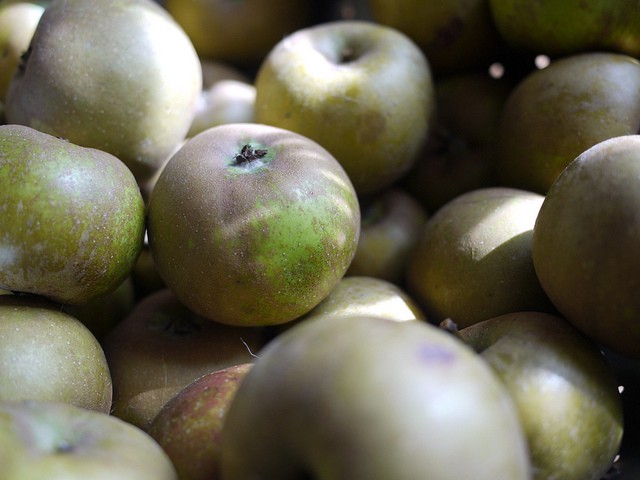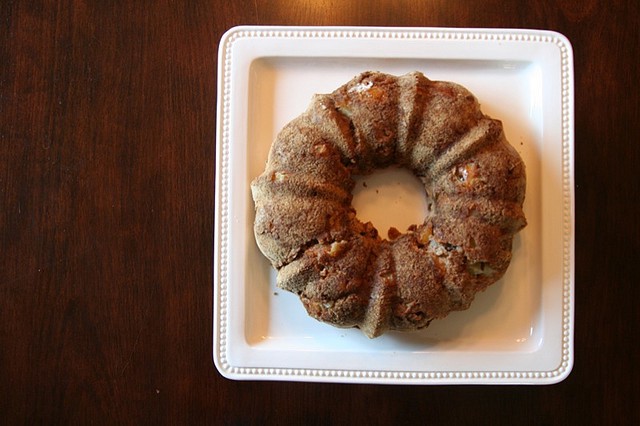Not Just Any Apple

New York has the best apples in the world. I say this grudgingly, since I am not a native New Yorker and prefer to argue about claims to New York’s superiority rather than accept them. But after four years of living in this ridiculous city, the facts are the facts: Washington may grow many more apples each year; Minnesota may have the best apple laboratories; and apples (well, besides crab-apples) may not even be native to this continent; but in terms of flavor and variety, I’ll hold up New York’s apples against anywhere in the world. That said, you’re probably buying the wrong ones.
I won’t even bother to dismiss the Red Delicious apple, still the most popular variety in the country; Sarah Yager at the Atlantic did a better job with that than I could. Instead I want to encourage New Yorkers, and other people who live in states which I’m sure do other things well but do not grow apples quite as well as New York, to try the ugly apples — the cheap and rough and blemished and unfamiliar apples.
Lately, it is not the red delicious that’s raised my ire, but the Honeycrisp, an apple developed just a few decades ago in labs in Minnesota. The Honeycrisp is an excellent walking-around apple, a hardy variety that lasts for weeks off the tree and boasts a spectacularly crisp texture. Perhaps no other apple boasts the *snap* of a Honeycrisp. But at the farmers market I see customers walk past a dozen other varieties in favor of the Honeycrisp, and this saddens me, for two reasons. First, the Honeycrisp is not especially flavorful; its sweetness and tartness is well balanced, but it lacks the punch-in-the-face apple flavor of other varieties. Second, it’s very expensive; a grower I know in Pennsylvania refers to them as “Moneycrisps” because he can charge two or three times as much for them as for other varieties, though it’s not really any harder to grow.
Now, if I’m in a grocery store and the choices are Red Delicious, Granny Smith, and Honeycrisp, I’d usually opt for the Honeycrisp. But not in New York, in the fall! Not when there are literally hundreds of heirloom varieties out there, crazy apples with flavors of pear and pineapple and spice and with a huge range of colors and textures. Branch out! Try the ones you’ve never heard of!
My current favorites are the Golden Russet and the Suncrisp. The former has russetting — a brown, rough-textured skin, like an Asian pear — which has been deemed unacceptable by new apple breeders, who assume that consumers aren’t interested in a dull, matte brown apple when gorgeous red-gold apples will be sitting in the next bin over. And yet: the Golden Russet is outstandingly flavorful, powerfully sweet and with a hint of nuttiness and almost a molasses flavor. It also has a good, firm texture (I have yet to find a mealy one). It’s an old variety probably created right here in New York, somewhere in the Hudson River Valley, and it is spectacularly delicious.
The Suncrisp is a near opposite of the Golden Russet: It, like the Honeycrisp, was created in labs only recently — this one at Rutgers in New Jersey. It’s a hybrid of the Golden Delicious (big, very sweet, not at all related to the Red Delicious) and a cross of the Cortland and Cox’s Orange Pippin, the latter of which is an excellent heirloom variety in its own right. The Suncrisp is a good transition from the Honeycrisp; it’s just as crisp, but the flavor is richer and more complex. Where the Honeycrisp has a sort of berry flavor, the Suncrisp is more like pineapple or some other tropical fruit. (I know these wine-tasting-like descriptions are pretentious and irritating but I have to get you people to buy interesting apples somehow, right?)

Cooked apples are something else entirely. Usually you cook them down pretty thoroughly, so texture isn’t quite as important — what you’re looking for with a cooking apple is the most intense possible flavor. This first recipe is an actual recipe, with actual measurements, because it isn’t mine; it’s my dad’s. It’s a Jewish apple cake, with caramelized apples, almost like a pineapple upside-down cake. It is excellent despite being a kosher dessert. I thought this was an old Jewish recipe, passed down for generations from the old country, but I called home to find out and apparently my dad just, like, got it off the internet about ten years ago and modified it slightly. It is, weirdly enough, a very common cake in Pennsylvania, where my parents live, probably with German roots. It is mostly sold there as a “German apple cake.” Anyway, here it is, written in my words rather than his because I’m a professional blogger and my dad is merely an accomplished and decorated research chemist.
Put three cups flour, a tablespoon of baking powder, a tablespoon of salt (his recipe calls for a teaspoon, but I like more salt than he does), two cups of brown sugar, four eggs, two and a half teaspoons of vanilla extract, a cup of canola oil, and a quarter cup of orange juice into a big bowl, and mix thoroughly. If you have a stand mixer, use it; if not, this is your exercise for the week. When smooth, pour half of the batter into a bundt cake pan. (I’ve used regular baking dishes with this and it doesn’t quite turn out right — you need more surface area for the edges of the cake to get crispy.)
Then make yourself some cinnamon sugar: about two teaspoons of cinnamon to three-quarters cups of brown sugar. (I only use brown sugar; I think my dad uses white, but he’s wrong.) Sprinkle about a quarter of this cinnamon sugar evenly over the batter’s surface, then layer down two apple’s worth of apple slices. My favorite apple for this is the Jonathan, an easy-to-find apple that I don’t much like eating raw, since its texture runs from not-particularly-crisp to mushy and mealy. But it has a huge flavor, and bakes really, really well. Anyway, lay those down, then sprinkle another quarter of your cinnamon sugar on top of the apples. Then pour the rest of the batter into the bundt pan, and do the same thing with the apples: cinnamon sugar, two apples’ worth of apple slices, cinnamon sugar. Bake at 300 degrees for seventy-five to ninety minutes, and use a cake tester like this one to tell when it’s done. It should be moist in the middle, but not wet.
As a lazy cook with zero patience or talent for baking, I make this cake maybe once a year at most. Instead, I most often make an apple crisp, because it’s less precise and you don’t actually have to measure anything. (Note: the differences between crisps, crumbles, buckles, and grunts are vague. I’m calling this a crisp, because that’s what I call it, but if it’s technically something else feel free to yell at me in the comments.) Take out a cast iron skillet and put it on medium heat, and throw in about a third of a stick of butter. Chop up five apples. I prefer thin slices that are then cut in half width-wise, but you’re going to be cooking them for so long you can pretty much do whatever you want. (This will seem like too much apple, but they’re going to reduce in size a lot.) As far as type of apples, I prefer Golden Delicious derivatives: Mutsu, Cameo, Opal, Pink Lady. Throw the apples in the pan and stir to cover them in butter, then add a pinch of salt, a small spoonful of honey, and a sprinkle of allspice. Stir again, cook if for a couple minutes to let the honey mix with the butter and the allspice toast, then add about a cap-full of apple cider vinegar. Turn the heat down to medium-low and let the apples cook for awhile, until they’re still distinct slices (you don’t want applesauce) but are soft.
While that’s happening, make your topping. In a big bowl, mix about two cups of regular rolled oatmeal (not Irish oats or quick-cook oats), a tablespoon of salt, a couple teaspoons of cinnamon, and about a cup of brown sugar, then take the rest of your stick of butter and mash it into your dry stuff. Cold butter is best; you want to form kind of blobs, not a uniform topping. I usually use my hands for this, just kind of squeezing the butter into the dry stuff until it’s all gone. When the apples are done, kind of shake the pan so they’re all spread evenly in there, then lay down your topping in a single layer on top of the apples, then slide the whole thing in a 350 degree oven until the topping is crisp and doesn’t taste like raw oats anymore, which could take between forty-five minutes and an hour. Serve with vanilla ice cream.
Apples can work in savory dishes, but they’re usually restricted to serving as sweet-sour accompaniments to pork, which is really more of a pork dish than an apple dish, or fall salads with raw apples — the sort with big chunks of fennel or kohlrabi or (christ) raw kale, and pecans or whatever (which are basically desserts with vegetables in them). I’d rather combine chicken with apples for a real simple braise, which I’ve simplified even further from this Serious Eats recipe. Get some cheap chicken parts with bones and skin, like legs or drumsticks, and pat them dry. Put a little bit of oil in your dutch oven or other big pot and sear the chicken on all sides until browned but not cooked through, then remove the chicken and stick ’em on a paper towel somewhere. In the rendered chicken fat, saute a chopped apple and a chopped red onion until softened, then pour in about a cup of hard apple cider (something more on the dry side, but probably not too funky), a pinch or two of salt, and a grind or two of pepper. Drink the rest of the apple cider while you stir to get all the sticky bits off the bottom of the pot. Then stick the chicken parts back into the pot, cover it, and turn the heat down to low. The chicken’s done when it falls off the bone. Serve over rice or mashed potatoes. If you want to step that recipe up, you could remove the chicken when done and work with the braising liquid a bit; some honey, some mustard, some sage, some smoked paprika, reduce it a bit more, maybe add in a roux (equal parts flour and fat), before pouring over the chicken. I usually don’t bother. It’s pretty good without all that stuff.
Apples are the one thing that unites everyone living in the parts of the country with garbage weather — the Northeast, the Midwest, and the Pacific Northwest. They are the one argument we can lob at those dickheads in California, who can grow anything in any month: Sure, you can grow tomatoes in February, but can you grow a good apple? Nope. Only we can.
Crop Chef is a column about the correct ways to prepare and consume plant matter, by Dan Nosowitz, a freelance human who enjoys hot salads and lives in Brooklyn, naturally.
Photos by Rebecca Siegel and Ali Edwards
